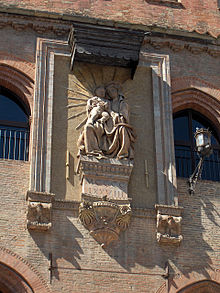Niccolò dell'Arca
Niccolò dell'Arca (* 1435-1440; † March 2, 1494 ) was an Italian sculptor of the early Renaissance . He is also known under the names Niccolò da Ragusa , Niccolò da Bari and Niccolò d'Antonio d'Apulia. The addition to the name "dell'Arca" refers to his contribution to the Arca di San Domenico .
life and work
Details of the place and year of his birth are uncertain. Presumably he was born in Puglia or maybe Bari , and after that he most likely lived in Dalmatia for a while . Gnudi (1973) writes that Niccolò learned there from the Dalmatian sculptor Giorgio da Sebenico .
Some art historians explain the Burgundian elements in his sculptures by saying that Niccolò worked on the triumphal arch of Castel Nuovo in Naples during the 1450s , where he would have been influenced by the Catalan sculptor Guillem Sagrera .
Others deny training in Naples and instead claim that Niccolò traveled to France in the late 1460s . His further training took place in Siena , influenced by the work of Jacopo della Quercia and Donatello .
He was mentioned for the first time in September 1462 in Bologna as Maestro Nicolò da Puglia , a "master of the terracotta figures". This probably refers to the group of terracotta figures “Lamentation of the Dead Christ” in the church of Santa Maria della Vita in Bologna, which Pope Paul II also mentions in his 1464 bull .
Other works are the terracotta bust of St. Domenic (1474) in the museum of the Domenic's Basilica in Bologna ; a marble statue of St. John the Baptist in the Escorial near Madrid; the terracotta figure of St. Monika (approx. 1478–1480) in the museum palace in Modena and the terracotta relief of the Madonna di Piazza (1478) on the facade of the Palazzo d'Accursio in Bologna: the influence of the drapery is evident by Jacopo della Quercia as well as traces of the dynamic naturalism of his contemporary Andrea del Verrocchio .
Compianto sul Cristo morto
The group of sculptures "Lamentation of the Dead Christ" consists of seven life-size figures. Six mourners complain about the lying body: Joseph of Arimathäa , Salome , the Holy Virgin Mary, the Evangelist John, Mary Cleophae and Mary Magdalene . Originally the terracotta figures were brightly painted. The head of the dead Christ rests on a pillow, which is signed Opus Nicolai de Apulia . Niccolò began working on the sculptures in 1463. The remarkable realism and psychological representation of the figures can be seen in connection with the suffering of the patients in the nearby hospital: the sculpture group was an important point of contact for family members and pilgrims for centuries, and the income from theirs Donations were so significant that they enabled the upkeep of the church and the hospital.
A formally comparable group of sculptures by Alfonso Lombardi can be found in the oratory next to the church.
literature
- Wilhelm von Bode : The Italian sculpture . ( gutenberg.org ).
- James H. Beck: Niccolo dell'Arca: A Reexamination . In: College Art Association (ed.): Art Bulletin . 47, No. 3, September 1965, pp. 335-344. JSTOR 3048280 3048280 . doi : 10.2307 / 3048280 .
- Alfonso D'Amato: I Domenicani a Bologna . Edizioni Studio Domenicano, Bologna 1988, pp. 93-96.
- Cesare Gnudi: Nuove ricerche su Niccolo dell'Arca 1973.
- J. Pope-Hennessy: Italian Renaissance Sculpture 1958, ISBN 0-394-72934-X .
- Randi Klebanoff: Sacred magnificence: civic intervention and the arca of San Domenico in Bologna . In: Journal of the Society for Renaissance Studies . 13, No. 4, December 1999, pp. 412-429. doi : 10.1111 / j.1477-4658.1999.tb00088.x .
- Karl Woermann : History of Art . tape 4 , 1919 ( limited preview in Google Book Search).
Web links
| personal data | |
|---|---|
| SURNAME | Niccolò dell'Arca |
| BRIEF DESCRIPTION | Italian sculptor |
| DATE OF BIRTH | around 1435 |
| DATE OF DEATH | March 2, 1494 |



